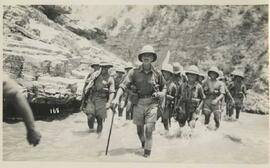ANDERTON, Col Geoffrey (1902-1981)
- ANDERTON
- Collection
- 1930-1953
Eighteen captioned photographs of operations in Waziristan, North West Frontier, India, Jul 1930, of troops of the Durham Light Infantry and 20 Medium Battery, Royal Artillery. Eight uncaptioned photographs of parades, groups and individuals officers, UK, 1940. Papers relating to the Allied campaigns in North Africa and Italy, 1943-1945, including printed map of Tunisia, scale 1: 1, 000, 000, 1943, and two printed maps of Anzio and the surrounding area, scales 1: 50, 000 and 1: 1, 000, 000, 1944; typescript 'The First Division in action. Tunisia 1943', with printed booklet entitled 'The First Divisional Artillery, Tunisia, 1943. Banana Ridge' [1943]; manuscript graph entitled 'Casualties-1st British Division and attached troops-Anzio', 21 Jan-6 Jun 1944; typescript report entitled 'The First Division in action, Anzio, March to June 1944'; typescript account by Anderton, Assistant Director of Medical Services, 1 Div, entitled 'History of the Divisional medical services in the Anzio campaign', Dec 1945; two volumes, History of the First Division. Anzio campaign. January-June 1944 (Ahva Press, Jerusalem, Palestine, [1946]) and History of the First Division. Florence to Monte Grande. August 1944-January 1945 (Schindler's Press, Cairo, Egypt, [1946]). Papers and photographs relating to Hong Kong and Korea, 1946-1952, including map of 'Hong Kong and the New Territories', scale 1: 80, 000, GSGS 3961, 1946; typescript memorandum by Anderton, as Deputy Director of Medical Services, Hong Kong, entitled 'The medical aspects of the expansion of the Hong Kong garrison in 1949', 1950; nineteen photographs of Korea and Hong Kong, 1950-1952, including visit by Edwina Cynthia Annette Mountbatten, Countess Mountbatten of Burma, to Hong Kong, 1950; large annotated manuscript map showing positions of UN medical units, near the Imjin river and north of Seoul, Korea [1951]; edition of the Journal of the Royal Army Medical Corps, Jan 1953, with article by Anderton entitled 'The birth of the British Commonwealth Division, Korea'. Typescript article on the Louise Margaret Hospital, Aldershot, 1949, with group photograph of the staff.
Anderton, Geoffrey, 1902-1981, Colonel


